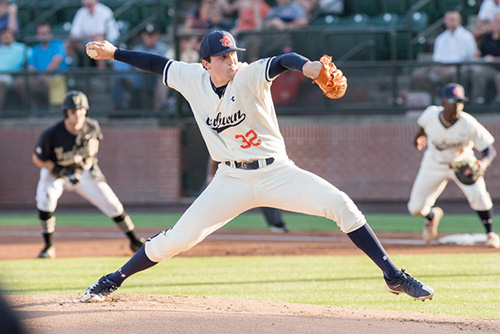
The first time I saw Casey Mize throw in person was last November. After competing with Team USA this past summer, he’d taken the Fall off from throwing and was just starting up our throwing program with our trainer Anthony Sanderson.
I had several first impressions of Casey in action, all of which were positive. He maintained balance from start to finish in his delivery and his direction to the target was really good. And, to my eye, he appeared to be ‘in sync’ with his upper and lower half in his movements. I knew enough about his history to know that he had exceptional command in game competition, and learned quickly that his bullpens were no different.
Casey continued to progress through our throwing program over Winter break. At no time did he ever experience an instance of unusual soreness, and he never felt like he needed an extra day or two of rest in between sessions. He was very much committed to what we were trying to do with our pitching program at Auburn and is one of the most regimented and committed players I’ve ever been around.
When Casey was away from Auburn, I know he spent of a lot of time in Nashville with Lantz Wheeler. He learned a lot from Lantz, including how to most efficiently use the core and hips throughout the delivery. Casey was intensely familiar with the Core Velocity Belt, which is endorsed by Lantz. Needless to say, I used Casey as a model and coach for the rest of our pitching staff, as I tried to expose them to all of the movements that the Core Velocity Belt emphasizes.
As I think back to all of his outings from this past Spring, his early-season no-hitter against Northeastern stands out the most. It was the first no-hitter at Auburn since 2002 and ninth in our program’s history. Much like Casey, it was a model of efficiency. He threw every one of his pitches— fastball, slider, cutter and splitter—for better than 60 (and closer to 75)-percent strikes. In his nine no-hit innings, he threw 77 strikes and 28 balls, good for a 73-percent strike rate. He struck out six of the first ten batters he faced, 13 in all, and did not issue a walk. Only a fourth inning throwing error kept his performance from being a perfect game. He was able to get the majority of his outs in the strike zone, with swing-and-miss stuff. It was the one of best pitching performances I have seen in my coaching career, and one that I will not soon forget.
Every time Casey took the mound, it came with lofty expectations. Casey had his own personal goals and objectives, the team had theirs, and the media had theirs. On top of all that was the stretch run our team made in the SEC Tournament, NCAA Regionals and Super Regional play, and the mounting likelihood that Casey was going to be the first overall selection in the MLB draft.
As we look at the images in Frame by Frame, I think that Casey would agree that they don’t necessarily reflect all of his movements at their best. While baseball is a game of repetition, it is difficult even for the best players to repeat their mechanics on the mound, at the plate and in the field. However, the foundation we lay through commitment level, training and regiment (all things Casey excelled at) can help players achieve success when they don’t have their “A” game— which is most of the time!